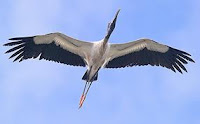There is an old myth that somehow has become a heritage to many cultures: the belief that babies are delivered the stork; it is certainly an easy way out when a curious young kid starts asking questions. I use to wonder, who came up with such an idea? Well, one of the myths came from Scandinavia and was promoted by Hans Christian Andersen. A second myth which is also very interesting, is the one that says that when a stork flies south for the winter, it visits the watery swamps of Egypt where the souls of unborn children live. Upon returning, it would carry a child back. The regular absence of the stork during migration made it a likely target for this myth. http://ww2.netnitco.net/users/legend01/stork.htm
It seems like the myths around the storks, lean on the fact that storks are deeply nurturing and protective of their young, very family-oriented and conscientious homemakers. They also return in pairs to the same nesting spot year after year. Storks are fertility symbols and are associated with springtime and birth.
In Costa Rica, we do not have the white-stork responsible for all those myths; however, we have a different variety called Wood-Stork; with over 1 meter height (3.3 ft.), Wood-Storks are the second tallest birds in Costa Rica, exceeded only by the Jabiru-Stork. Their plumage is white with black feathers on the bottom of their wings. They look odd with their unusual and bald head, but they fly gracefully. These are gregarious birds; they nest in dense colonies atop mangrove or other trees by the water.
Wood-Storks are very common in the north and central pacific of Costa Rica; however, last week we started seeing them on the mangrove trees between the beach and the backyard of our house in Costa Ballena (Southern Pacific). It has been quite a joy to see them flying so gracefully and perching on the trees in large numbers.
Wood-Storks use their massive beak as a tool for food gathering. They feed in waters no deeper than their beak and catch the food, and then they toss their heads back and swallow it. Storks do not use their vision while they collect the food; they simply do it by touch. They appear to have a super high reflex response on their bill after they touch food. Their diet includes: fish, crayfish, tadpoles, salamanders, shrimp, frogs, insects and occasionally baby gator. They also use their feet to stir the bottom of the water that helps to separate the prey from the vegetation and besides; it creates the water movement of a “feeding frenzy that might attract fish to become prey. Wood storks are big eaters and usually feed in flocks.
Wood-Storks can glide for extensive periods of time on warm currents at up to 300 meters or more, and sometimes they dive and flip, as they soar down from high in the sky. They fly with slow wing beats, with their long and broad wings, soaring and circling like hawks. They are unbelievable acrobats when performing turns, dives and rolls. They fly with outstretched head and legs.
Wood-Storks like to nest in large colonies. The nesting period is different based on the geography; however, it always synchronizes with
the most plentiful to feed and raise their chicks. They like to nest on high trees, 30 mts /98 ft, more or less. A pair (couple) of wood-storks will build the nest with sticks, vines, leaves and Spanish moss, turning it into a shallow cup/platform where the female will lay the 2 to five creamy-white eggs, one or two days apart. They have an incubation period that last around 30 days and is a shared task between male and female. The chicks hatch at different times; therefore, the nestlings will differ in size during the first few weeks; this is the time when they need the most attention from their parents. During their first week, the chicks are feed 15 times a day by regurgitation. Parents provide shade to their young by spreading their wings, and carrying water on their throats, to dribble it over the chicks. They usually leave the nest at about nine weeks of age. They reach their sexual maturity at 4 years old. This species produces only one brood per season.
Wood-Storks live between 11 and 18 years their body size goes from: 33 to 45 in (85 to 115 cm); from beak to toes, they can reach 3.3 ft. They have a wingspan of 4.9 to 5.8 ft (1.5 to 1.8 m). Their identifying features are their pink feet.
Wood-Storks are quiet birds, usually silent. Sometimes they make a croak noise, much like the bullfrog, and upon occasion, they hiss like a snake.
When you visit Costa Rica, there is a good chance that you will get to see these mythical creatures; after all they have their vacation home here.
pictures by Bill Wright






No comments:
Post a Comment